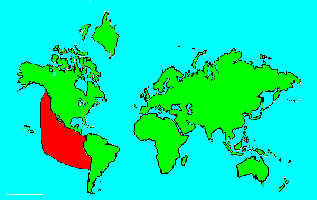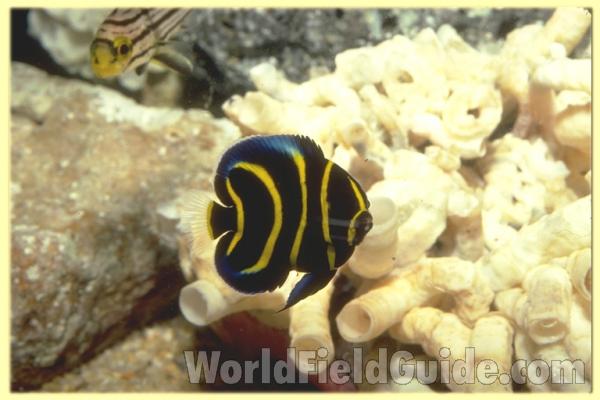SPECIES INFO
Cortez Angelfish (Pomacanthus zonipectus) is found from Baja California in the eastern Pacific Ocean as far south as Peru. Young specimens are black with orange stripes. As the fish get older the stripes and the background black color fade. The adult is almost silver and dark gray.Pomacanthus genus of angel fish is represented in tropical zones of all three major oceans. The Kuiter coastal fishes on SE Australia book mentions one species. Two popular guides that include the Caribbean each mention two species. The excellent Princeton 2002 edition guide to worldwide coral reef fishes pictures 11 different species. The Burgess-Axelrod book that covers Californian and West Mexican marine species shows 6 images showing different color variations of a single species. Some of the species can reach 20 inches, but most are somewhat smaller reaching around 16 inches in length.
Many species have juvenile forms that are black with pale vertical bands in contrast to the very different adult coloration schemes.
The Pomacanthidae includes the genera Centropyge, Genicanthus, Pomacanthus, and Holocanthus. There are about a seven genera and about 80 species in this group. Although these are related to the butterfly fishes, these fish are usually larger and more spectacular. Their popularity with the hobby aquarium industry has led some European countries to ban imports of this entire family. The larger members can reach 14 inches in length, while the smaller members can be up to only 4 inches in length.
Butterfly fish, family Chaetodontidae, are a group of small marine fish that inhabit the reefs of the world. There are many species in the group, many of which are both beautiful and abundant. There are about 115 species distributed among ten genera. The marine angel fish family (Pomacanthidae) is combined herein with its additional perhaps 50 species. The Pomacanthidae includes the genera Pomacanthus and Holocanthus. We have then divided this family into the two typically recognized families.
Perch-like Fish, Order Perciformes, are the largest order of fish in both freshwater and shallow saltwater. Most of the conventional fish belong to this order. The bass, bluegills, perch and crappies of freshwater plus the groupers and sea bass of salt water belong to this order. The fish all have spiny rays in their fins and the tail fin has seventeen rays. There are approximately 150 families. Herein, we have placed the families in alphabetical sequence within this order. (In some instances the typical taxonomic sequence of families is not much help. Consider, for example, that the barracudas are usually placed between the mullets and the threadfins.)
Bony fish, Class Teleostomi, are a class of chordates that include the majority of fish-like animals found on earth. They are characterized by a bony jaw and a bony skeleton. They are found in both fresh and marine waters.
Backboned Animals (Phylum Chordata) are the most advanced group of animals on earth. These animals are characterized by having a spinal cord or backbone. Most members have a clearly defined brain that controls the organism through a spinal cord. Fish, amphibians, reptiles, birds, and mammals are in this phylum.
Currently, some taxonomists believe that the fish should be divided into two groups (sharks and regular fishes) and that there are some other primitive groups in the phylum such as hagfish or lampreys.
Animal Kingdom contains numerous organisms that feed on other animals or plants. Included in the animal kingdom are the lower marine invertebrates such as sponges and corals, the jointed legged animals such as insects and spiders, and the backboned animals such as fish, amphibians, reptiles, birds, and mammals.


